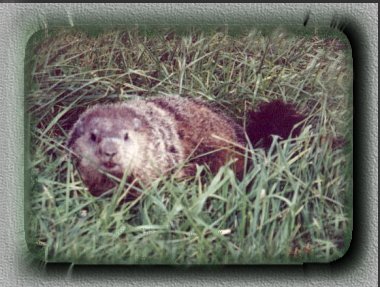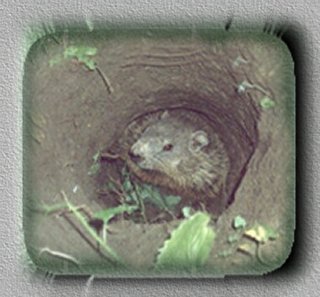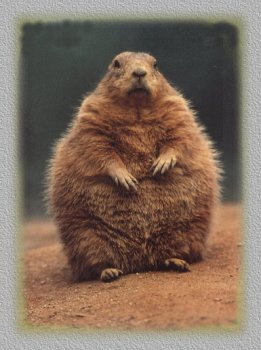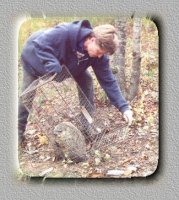



The common name woodchuck, stems
from a generic name, woochuk,
used by the Cree tribe to describe all marmots. We tend to call this
ground dwelling rodent a groundhog, whose name speaks for itself.
His body length can be as much as 20+"; his tail from 4-7 inches long and
he can weigh up to 15+ lbs. Their range is from the middle U.S. to the East
coast and from northern sections of Mississippi, Alabama, Georgia, and
South Carolina on up into southern Canada. The groundhogs diet consists
of meadow plants such as clovers, alfalfa, plantains, dandelions, cresses,
and violets, but it also eats raspberries, blueberries, and beechnuts along
with a variety of grasses and their roots. Fruit trees are also fair
game, such as apple, cherry and pear. The groundhog's willingness
to live in close proximity of humans, its voracious appetite, and its need
to dig holes that can break the legs of livestock make it a pest in farming
communities. Some of these holes are big enough to sink farm
equipment wheels causing axle damage and tremendous farm equipment repair
expenses. An overpopulation can seriously damage corn, beans, and
other crops, or even wipe out a family garden. In the groundhog's
defense, it's digging habits help aerate the soil, making it better for
growing crops, and concentrated scat deposits are very good fertilizer.
weigh up to 15+ lbs. Their range is from the middle U.S. to the East
coast and from northern sections of Mississippi, Alabama, Georgia, and
South Carolina on up into southern Canada. The groundhogs diet consists
of meadow plants such as clovers, alfalfa, plantains, dandelions, cresses,
and violets, but it also eats raspberries, blueberries, and beechnuts along
with a variety of grasses and their roots. Fruit trees are also fair
game, such as apple, cherry and pear. The groundhog's willingness
to live in close proximity of humans, its voracious appetite, and its need
to dig holes that can break the legs of livestock make it a pest in farming
communities. Some of these holes are big enough to sink farm
equipment wheels causing axle damage and tremendous farm equipment repair
expenses. An overpopulation can seriously damage corn, beans, and
other crops, or even wipe out a family garden. In the groundhog's
defense, it's digging habits help aerate the soil, making it better for
growing crops, and concentrated scat deposits are very good fertilizer.

 sighted or scented, a woodchuck typically raises itself erect on its haunches
to get a better look and smell. The territory claimed by an adult
is always small, usually no more than 3 acres, but size is ultimately determined
by available food supply. They have been found mating as early as
February through April, depending once again on their location. After
a brief courtship, the male moves into a female's den and stays for about
a week, the only time these normally solitary animals actually live together.
There is no bonding and the male takes no part in rearing the young.
Gestation time is a month, with 4 - 6 blind, hairless young born in a deep,
subterranean chamber lined with soft grasses. At one month, the babies
open their eyes and begin to crawl about the birthing chamber. At
about 6 weeks they emerge from the den to forage for solid foods with their
mother. At two months the youngsters dispense to establish their
own territories. Groundhogs have one litter per year.
sighted or scented, a woodchuck typically raises itself erect on its haunches
to get a better look and smell. The territory claimed by an adult
is always small, usually no more than 3 acres, but size is ultimately determined
by available food supply. They have been found mating as early as
February through April, depending once again on their location. After
a brief courtship, the male moves into a female's den and stays for about
a week, the only time these normally solitary animals actually live together.
There is no bonding and the male takes no part in rearing the young.
Gestation time is a month, with 4 - 6 blind, hairless young born in a deep,
subterranean chamber lined with soft grasses. At one month, the babies
open their eyes and begin to crawl about the birthing chamber. At
about 6 weeks they emerge from the den to forage for solid foods with their
mother. At two months the youngsters dispense to establish their
own territories. Groundhogs have one litter per year.

Of all the quarry that is recognized by the Jack Russell Terrier Club of
America, groundhog tracks are unique to all others. As a member of
the squirrel family, they only have four toes on their front feet and five
on their hind feet. Their toes are elongated ending with enlarged
"fingertips". Forefeet average 1 1/2 to 2" long and hind feet 2 to
2 1/2". They walk flatfooted on level surfaces most of the time,
but there's a tendency to walk on the balls of their hind feet only, keeping
the heels airborne, which will make their hind tracks shorter than the
foreprints. This is best seen with a good clear track where you will
see a deep impression at the toes, ascending gradually farther back until
merging indistinctly with the surface. Their stride, or distances
between pairs, is 3 to 4 inches.
Another unique characteristic of the groundhog is his highpitched whistle,
which sounds much like a human whistling through his teeth. This
is an alarm whistle which groundhogs and other wildlife respond appropriately
to. When challenged, he will also make a loud, fast chattering of
teeth which warns his adversary that he is willing to stand his ground.
| When I first started
hunting
groundhogs for the farmers who wanted them gone, it was important for me to harvest all I could capture. Since the birth of Groundhog Retreat, it has become my personal mission to study their characteristics, responses, and habits. It's a real challenge to capture them unharmed which I'm able to do in most cases. |
 |
They are then released
in an existing groundhog sette beside the lush alfalfa fields I planted
for them. They get a pat and a "thank you" for an enjoyable
and usually a very challenging hunt. Without them, my terriers and
I wouldn't have been able to enjoy what we love and live to do.
This little guy on the left isn't quite sure about his new home. |

